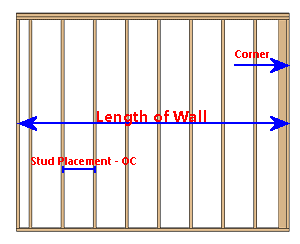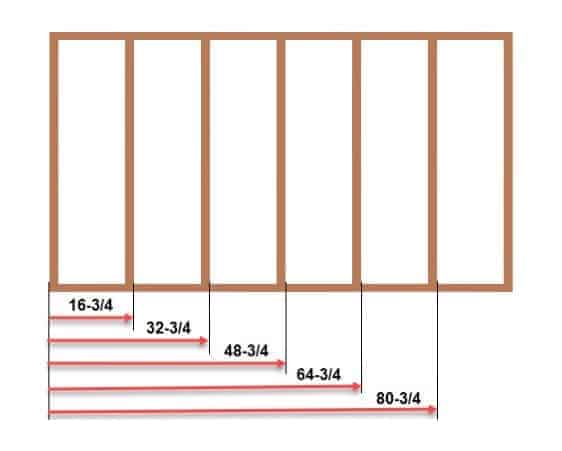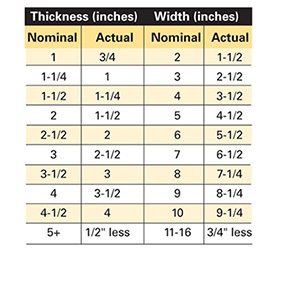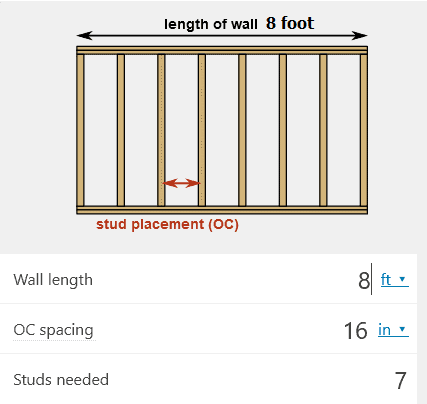Studs are short vertical pieces of wood used to form a wall or building. The size of the wall is typically that height, so you need to know how many studs you will use to build that. You’re on the right page if you ever wonder how long studs are for an eight-foot wall!
Below is the presented length of the wall:

Lumber dimensions are specific when we measure width and thickness because we measure 1/2 inch less than the size of the lumber.

What does two by 4, 2 by 8, or 2 by ten mean?
For example, two-by-four wood means the nominal thickness is 2 inches, and the nominal width is 4 inches. However, in reality, we have lumber that is 1 1/2 inches thick and 3 1/2 inches wide.
For example, two by eight means 2 inches nominal thick, and 8 inches nominal wide measures half an inch less. In reality, we have 1 1/2 inches thick and 7 1/2 inches wide lumber. A 2-by-10 measures 9 1/4 inches wide lumber.

How long are studs for an 8-foot wall?
For an 8-foot wall, each stud should be 92 5/8 inches long. You will have seven studs with 16 inches of OC spacing. Usually, 8-foot wall studs are 2-by-6 and 2-by-4.

Calculation:
If you have an 8-foot wall, it is 96 inches long. Usually, there are seven studs.
96 inches – 3.375 inches = 92 5/8 inches
As a general rule of thumb, the studs for an 8-foot wall should be 92 5/8 inches long. To determine the length of the studs for your project, measure the wall and subtract 1 1/2 inches from that number—the framing width.
Subtraction is required because it’s essential to remember that studs don’t meet up against walls. There’s a tiny gap between them so that they can shift with changes in humidity without cracking walls or corrupting paint jobs. This space, known as framing width, measures 1 1/2 inches and should be accounted for when measuring and cutting studs.
How long are studs for a 9-foot wall?
For a 9-foot wall, each stud should be 104 5/8 inches long. You will have eight studs with 16 inches of OC spacing. Usually, 9-foot wall studs are 2-by-6 and 2-by-4.
This is based on standard dimensional lumber, which has a specific length.
If you’re building a new home or repairing a damaged wall, you may wonder how long your studs should be. In this article, we’ll look at the factors that determine wall stud length, including what kind of lumber you use and the size of your ceiling height. First off, let’s talk about types of lumber. Many different kinds of lumber are available to consumers today, but they all have one thing in common: they must be cut to order before being purchased. That can make choosing which size studs you need for your walls difficult. First, let’s take a look at some standard lengths used when installing walls in homes today:
*two-by-four (2×4) – 8 feet long
*three-by-six (3×6) – 10 feet long
*four-by-eight (4×8) – 12 feet long
The actual finished length of a standard 2×4 is 1 ½ inches thick and 3 ½ inches wide.
The actual finished length of a standard 2×4 is 1 ½ inches thick and 3 ½ inches wide. The nominal size of a stud is the size of the lumber before it’s dressed, planned, or sanded down to its final dimensions. This means 2×4 measures 1 ½ inches thick by 3 ½ inches wide. Follow these steps to measure the length of your studs:
- Use your tape measure to measure from one edge of the wall to another
- Account for any drywall you plan on installing over the top – this will add about ¼ inch per side
- Measure from each end piece toward the center
You should be able to get an accurate measurement by simply measuring from one corner of the wall to another. However, if you have an enormous fence or are not confident in your measurements, try adding each stud instead.
This may sound odd since when you go to the building supply store, you’re buying lumber by the board foot, and it usually comes in 8-foot lengths. This is why this is a common misconception and how misunderstanding can lead to confusion.
The main reason there’s so much misunderstanding about this is that lumber is commonly sold by the board foot, but that’s not the same as the actual when.
However, when you add up the thickness and width of this, that doesn’t make sense.
A 2×4 is 1-1/2 inches thick by 3-1/2 inches wide. Adding those numbers together would give 5 inches. If that’s true, how can a standard wall stud be 8 feet long? It’s not possible. The only other option is that the lumber is shorter than 8 feet. But if that’s true, why?
You might also wonder: Why are studs for an 8-foot wall 92-5/8? Both questions lie in the lumber industry standards the American Lumber Standards Committee (ALSC) set forth. This independent organization sets U.S. standards for all lumber products sold commercially in the United States and Canada. These standards are essential because they ensure consistency in measurement so builders can confidently order when they know exactly what they are getting every time they buy construction materials and supplies.
There are also other lengths of dimensional lumber, including 8′ 4″, 10′ 2″, and 12′ 1″ long 2x4s and 6′ 9 ½” long 2x6s.
This is because of the standard 8-foot length that all lumber must be cut to. You can get them in longer lengths in some cases, such as 2x4s. However, since 1×4 material is often made from a board that’s already been run through a planer and has its edges ripped off to make it 1″ thick and 4″ wide, you’ll never find an 8′ long 1×4.
Other lengths of dimensional lumber are also available, including 8′ 4″, 10′ 2″, and 12′ 1″ long 2x4s and 6′ 9 ½” long 2x6s. Pre-cut stud lengths are also available: 92 5/8 inches (104 5/8) and 120 7/8 inches (122 7/8).
You can use these if you want to build something extra long without having to butt two pieces of lumber together.
You’ll need to combine two standard 8-foot boards (or less) for taller walls to meet whatever requirement your city’s code might have.
It would help to cut the pieces so they’re each 8 feet long.
Depending on whether your project requires a particular length, you may be able to use standard stock rather than cutting your boards or piecing together two smaller boards—or perhaps you do want those choices.
The most common lumber lengths are 8 feet, 10 feet, and 12 feet. There may be some variance from this norm; for example, a 2×8 board might measure 94 3/4 inches—but it’s still an 8-footer. All these lengths are nominal. They don’t refer to the actual dimensions of the lumber but rather how it was cut from logs and planed down from rough-cut boards into finished planks.
Conclusion
When it comes to buying lumber for framing projects, it is relatively easy to determine the length of any studs you need: Subtract 1½ inches from the total height of the wall (the standard height for interior walls is 8 feet) and use that figure as your guide to purchasing studs at a home center or lumberyard, for an 8-foot fence, that means picking up studs 7 feet 6½ inches in length (8 minus 1½ equals 6½). If you are building an exterior wall below ground level with concrete block foundation walls on each side of the wood frame wall and insulating in between them (a 2 x 4-inch “stud” cavity), then you would subtract ½ inch instead of 1½ because there will be ¾ inch drywall on one side only (as opposed to ½ inch drywall on both sides for interior walls).





